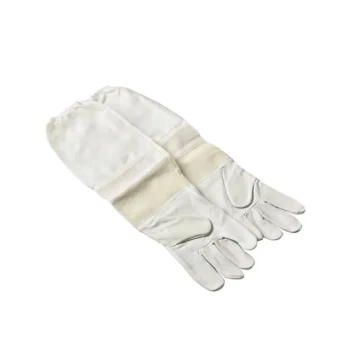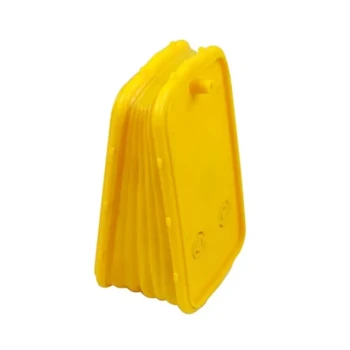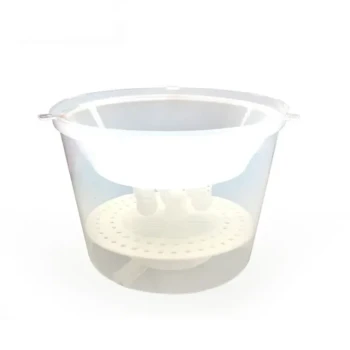To clean beekeeping gloves, you must first brush off loose debris, then gently wipe the surface using a mild soap and water solution, being careful not to soak the material. After wiping away the soap residue, allow the gloves to air dry completely away from direct heat. For leather gloves, finish by applying a leather conditioner to restore suppleness and prevent cracking.
The core principle of cleaning beekeeping gloves, particularly leather ones, is to avoid saturation. A gentle surface cleaning followed by proper drying and conditioning is essential to maintain their integrity and prolong their useful life.
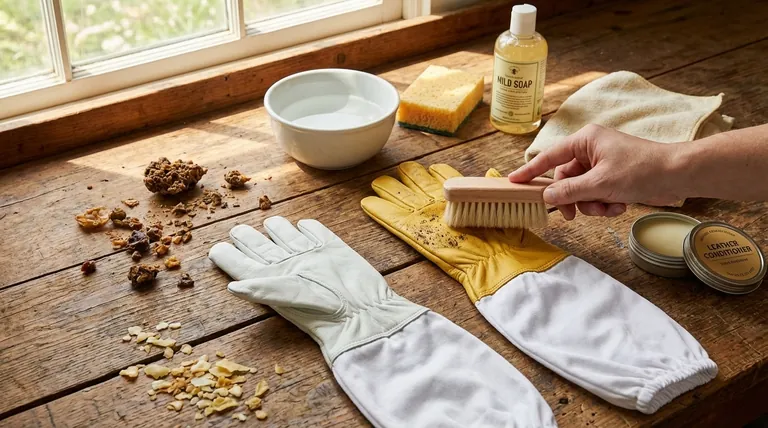
The Essential Cleaning Process for Leather Gloves
Leather gloves require a specific, gentle approach to prevent the material from becoming stiff, brittle, or damaged.
Step 1: Remove Surface Debris
Before introducing any moisture, use a soft brush to remove all loose dirt, dried wax, and propolis from the surface. Pay close attention to the seams and crevices where debris tends to accumulate.
Step 2: Prepare a Gentle Cleaning Solution
Mix a small amount of mild soap or a dedicated leather cleaner into a bowl of lukewarm water. Avoid using harsh detergents or chemicals that can strip the natural oils from the leather.
Step 3: Wipe, Don't Soak
This is the most critical step. Dip a soft cloth or sponge into your cleaning solution, wring it out so it is damp, not dripping, and gently wipe down the entire surface of the gloves. Soaking the leather will cause it to become stiff and can lead to cracking once dry.
Step 4: Rinse Carefully
Use a separate clean cloth dampened with plain water to wipe away any soap residue. Again, the goal is to remove the cleaner without saturating the gloves with water.
Handling Special Cases and Materials
Different situations and glove materials call for slightly different techniques.
Tackling Tough Stains (Propolis and Grime)
For stubborn stains, you can create a paste from baking soda and water or use a small amount of white vinegar. Always test your chosen cleaning agent on a small, inconspicuous area first to ensure it doesn't discolor the leather.
Cleaning the Gauntlets (Sleeves)
The cloth or canvas sleeve portion of the glove can often be cleaned more robustly. You can soak just the cloth part in a solution of water and a small amount of bleach (approximately 1/3 cup per gallon) to freshen it, but take great care to keep the bleach solution off the leather.
For Synthetic Gloves (Nitrile/Rubber)
If you use nitrile or rubber gloves, the process is much simpler. These non-porous materials can be washed thoroughly with soap and water and then air-dried without any risk of damage.
The Critical Post-Wash Steps
What you do after cleaning is just as important as the cleaning itself for ensuring the longevity of your gloves.
Proper Air-Drying Technique
Never use a machine or direct heat source like a radiator or hairdryer to dry your gloves. Pat them with a clean towel to remove excess moisture and then let them air dry in a well-ventilated area away from direct sunlight. Stuffing them with tissue paper can help them retain their shape as they dry.
The Importance of Conditioning
Once the leather gloves are completely dry, they will have lost some of their natural oils. Apply a small amount of leather conditioner with a soft cloth to restore flexibility and prevent cracking. Goat leather absorbs oils more easily, so use conditioner sparingly on this material.
Correct Storage Practices
Ensure your gloves are 100% dry before storing them to prevent mold and mildew. Keep them in a cool, dark, and dry place inside a breathable bag—never plastic. Protect them from pests like mice, which can be attracted to the material.
Understanding the Trade-offs
It is crucial to set realistic expectations for your equipment.
Perfection is Not the Goal
Beekeeping gloves are tools, and they will never look brand new again after use. The goal of cleaning is to maintain hygiene and function, not to restore their original appearance. Stains from propolis are notoriously difficult to remove completely.
The Risk of Over-Cleaning
Aggressive or frequent cleaning with harsh chemicals will do more harm than good. Each cleaning cycle strips some natural oils from leather, and excessive scrubbing can weaken the material. Prioritize gentle cleaning only when necessary.
A Cleaning Strategy for Your Gloves
Choose your approach based on your specific equipment and goals.
- If you have leather gloves (cow or goat): Your primary focus is preserving the material. Use the gentle wipe-not-soak method and always follow up with a leather conditioner after they are fully dry.
- If you have synthetic gloves (nitrile or rubber): Your goal is simple hygiene. Wash them thoroughly with soap and water after use and let them air dry.
- If you are dealing with heavy propolis stains: Spot-treat the stains carefully with a tested solution like vinegar or baking soda, accepting that complete removal may not be possible without risking damage to the leather.
Properly maintaining your gloves ensures they remain a reliable piece of protective equipment for many seasons to come.
Summary Table:
| Cleaning Step | Key Action | Important Note |
|---|---|---|
| Remove Debris | Brush off loose dirt, wax, and propolis. | Use a soft brush; avoid scratching the leather. |
| Gentle Cleaning | Wipe with a damp cloth and mild soap solution. | Do not soak leather gloves; keep them damp, not wet. |
| Rinse & Dry | Wipe away soap residue and air dry completely. | Avoid direct heat or sunlight to prevent cracking. |
| Condition (Leather) | Apply leather conditioner after drying. | Restores flexibility and prevents brittleness. |
Protect your apiary investment with gear built to last. Proper glove maintenance is just one part of successful beekeeping. At HONESTBEE, we supply commercial apiaries and beekeeping equipment distributors with high-quality, durable supplies designed for professional use. From gloves and smokers to hive tools and extractors, our wholesale-focused operations ensure you get reliable equipment that stands up to the rigors of daily beekeeping. Let’s discuss your needs — contact our team today to explore our full product range and wholesale pricing.
Visual Guide
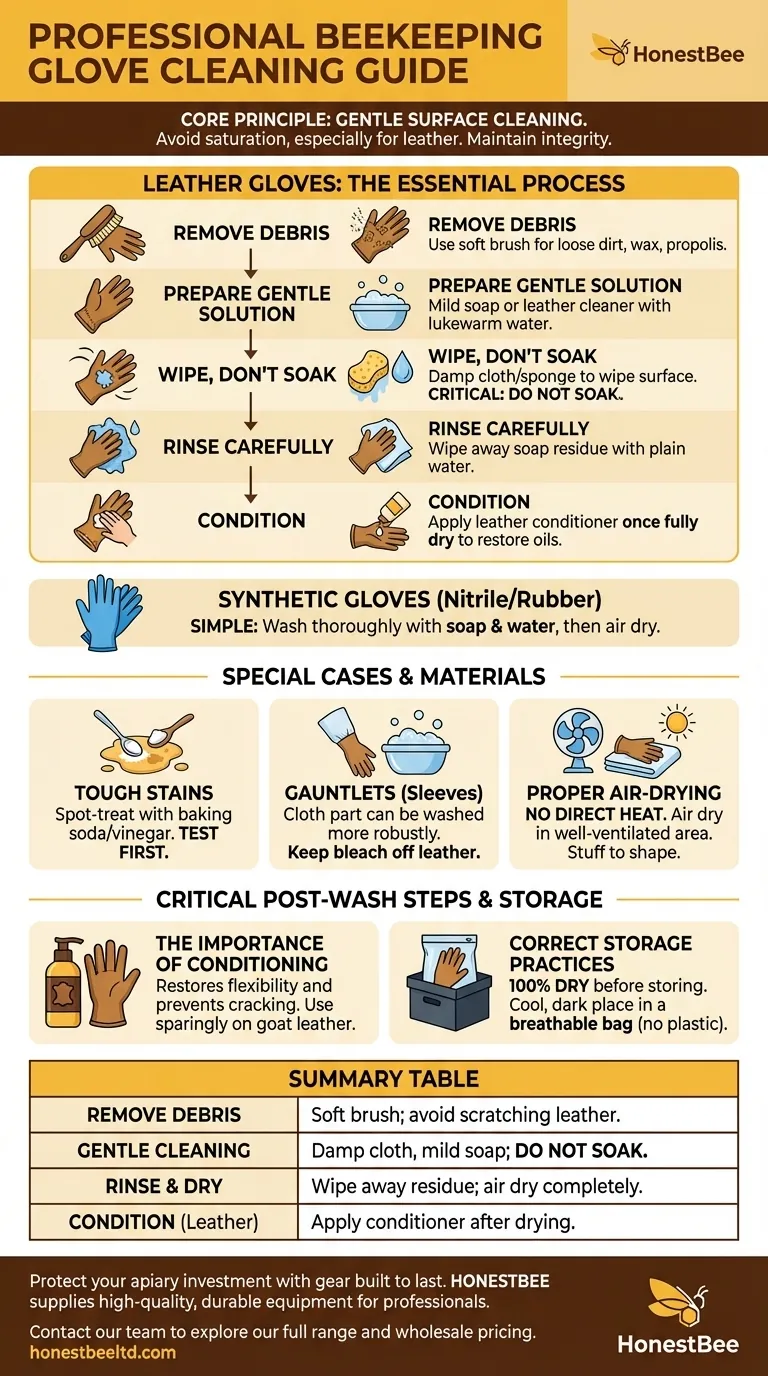
Related Products
- Beekeeping Gloves Goatskin Leather with Long Cotton Sleeve for Beekeepers
- Goatskin Leather Beekeeper Gloves with Vent Long Sleeve for Beekeeping Honey Bee Sting Proof Protection
- Goat Skin Leather Bee Sting Proof Beekeeping Gloves with Canvas Sleeve
- Mesh Ventilated 3 Layer Goatskin Beekeepers Gloves for Beekeeping
- Professional Beekeeping Suit for Kids and Girls Childrens Bee Keeper Suit
People Also Ask
- Why do some experienced beekeepers choose not to wear gloves? For Superior Dexterity & Hive Welfare
- Should beekeepers wear gloves, and why? Essential Protection for Beekeepers
- What are the arguments for and against using gloves in beekeeping? Balancing Protection and Dexterity
- What is the safest way to handle frames in beekeeping? Master Gentle Handling for a Calm Hive
- Why is dexterity and flexibility important in beekeeping gloves? Boost Your Hive Management Efficiency

